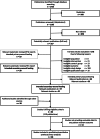Negative pressure wound therapy in patients with wounds healing by secondary intention: a systematic review and meta-analysis of randomised controlled trials
- PMID: 33038929
- PMCID: PMC7548038
- DOI: 10.1186/s13643-020-01476-6
Negative pressure wound therapy in patients with wounds healing by secondary intention: a systematic review and meta-analysis of randomised controlled trials
Abstract
Background: Negative pressure wound therapy (NPWT) is a widely used method of wound treatment. We performed a systematic review of randomised controlled trials (RCTs) comparing the patient-relevant benefits and harms of NPWT with standard wound therapy (SWT) in patients with wounds healing by secondary intention.
Methods: We searched for RCTs in MEDLINE, Embase, the Cochrane Central Register of Controlled Trials, and study registries (last search: July 2018) and screened reference lists of relevant systematic reviews and health technology assessments. Manufacturers and investigators were asked to provide unpublished data. Eligible studies investigated at least one patient-relevant outcome (e.g. wound closure). We assessed publication bias and, if feasible, performed meta-analyses, grading the results into different categories (hint, indication or proof of a greater benefit or harm).
Results: We identified 48 eligible studies of generally low quality with evaluable data for 4315 patients and 30 eligible studies with missing data for at least 1386 patients. Due to potential publication bias (proportion of inaccessible data, 24%), we downgraded our conclusions. A meta-analysis of all wound healing data showed a significant effect in favour of NPWT (OR 1.56, 95% CI 1.15 to 2.13, p = 0.008). As further analyses of different definitions of wound closure did not contradict that analysis, we inferred an indication of a greater benefit of NPWT. A meta-analysis of hospital stay (in days) showed a significant difference in favour of NPWT (MD - 4.78, 95% CI - 7.79 to - 1.76, p = 0.005). As further analyses of different definitions of hospital stay/readmission did not contradict that analysis, we inferred an indication of a greater benefit of NPWT. There was neither proof (nor indication nor hint) of greater benefit or harm of NPWT for other patient-relevant outcomes such as mortality and adverse events.
Conclusions: In summary, low-quality data indicate a greater benefit of NPWT versus SWT for wound closure in patients with wounds healing by secondary intention. The length of hospital stay is also shortened. The data show no advantages or disadvantages of NPWT for other patient-relevant outcomes. Publication bias is an important problem in studies on NPWT, underlining that all clinical studies need to be fully reported.
Keywords: Benefit assessment; Negative-pressure wound therapy; Publication bias; Systematic review; Wound healing.
Conflict of interest statement
SG and the research institute of HB each received an honorarium from IQWiG for their contributions to the HTA that formed the basis for this publication. The other authors declare no competing interests.
Figures







Similar articles
-
Rigid dressings versus soft dressings for transtibial amputations.Cochrane Database Syst Rev. 2019 Jun 17;6(6):CD012427. doi: 10.1002/14651858.CD012427.pub2. Cochrane Database Syst Rev. 2019. PMID: 31204792 Free PMC article.
-
Topical treatment for facial burns.Cochrane Database Syst Rev. 2020 Jul 29;7(7):CD008058. doi: 10.1002/14651858.CD008058.pub3. Cochrane Database Syst Rev. 2020. PMID: 32725896 Free PMC article.
-
Negative pressure wound therapy for wounds healing by primary intention: IQWiG Reports – Commission No. N17-01B [Internet].Cologne (Germany): Institute for Quality and Efficiency in Health Care (IQWiG); 2019 Sep 25. Cologne (Germany): Institute for Quality and Efficiency in Health Care (IQWiG); 2019 Sep 25. PMID: 31738498 Free Books & Documents. Review.
-
The use of negative pressure wound therapy following stoma reversal: a systematic review and meta-analysis of randomized controlled trials.Int J Colorectal Dis. 2025 Mar 20;40(1):73. doi: 10.1007/s00384-025-04865-2. Int J Colorectal Dis. 2025. PMID: 40111521 Free PMC article.
-
Negative pressure wound therapy for surgical site infections: a systematic review and meta-analysis of randomized controlled trials.Clin Microbiol Infect. 2019 Nov;25(11):1328-1338. doi: 10.1016/j.cmi.2019.06.005. Epub 2019 Jun 17. Clin Microbiol Infect. 2019. PMID: 31220604
Cited by
-
The antibiotic bead pouch - a useful technique for temporary soft tissue coverage, infection prevention and therapy in trauma surgery.J Bone Jt Infect. 2023 Jun 21;8(3):165-173. doi: 10.5194/jbji-8-165-2023. eCollection 2023. J Bone Jt Infect. 2023. PMID: 37818255 Free PMC article. Review.
-
Healing of diabetic foot ulcer in an amputation candidate with below-knee cellulitis using combination of negative pressure wound therapy and platelet-rich plasma injection: A case report study.Int J Surg Case Rep. 2025 Feb;127:110838. doi: 10.1016/j.ijscr.2025.110838. Epub 2025 Jan 3. Int J Surg Case Rep. 2025. PMID: 39799842 Free PMC article.
-
Functional and Clinical Outcomes in Acute Wound Management: Measuring the Impact of Negative Pressure Wound Therapy and Specialized Physical Therapy.Life (Basel). 2025 Mar 21;15(4):511. doi: 10.3390/life15040511. Life (Basel). 2025. PMID: 40283066 Free PMC article.
-
Ambulatory negative pressure wound therapy of subcutaneous abdominal wounds after surgery: results of the SAWHI randomized clinical trial.BMC Surg. 2022 Dec 12;22(1):425. doi: 10.1186/s12893-022-01863-x. BMC Surg. 2022. PMID: 36503505 Free PMC article. Clinical Trial.
-
Negative pressure wound therapy for surgical wounds healing by secondary intention is not cost-effective.Br J Surg. 2025 Apr 30;112(5):znaf077. doi: 10.1093/bjs/znaf077. Br J Surg. 2025. PMID: 40326752 Free PMC article.
References
-
- Graham ID, Harrison MB, Nelson EA, Lorimer K, Fisher A. Prevalence of lower-limb ulceration: a systematic review of prevalence studies. Adv Skin Wound Care 2003; 16(6): 305-316. - PubMed
-
- Kaltenthaler E, Whitfield MD, Walters SJ, Akehurst RL, Paisley S. UK, USA and Canada: how do their pressure ulcer prevalence and incidence data compare? J Wound Care 2001; 10(1): 530-535. - PubMed
-
- Persoon A, Heinen MM, van der Vleuten CJ, de Rooij MJ, van de Kerkhof PC, van Achterberg T. Leg ulcers: a review of their impact on daily life. J Clin Nurs 2004; 13(3): 341-354. - PubMed
-
- Argenta LC, Morykwas MJ. Vacuum-assisted closure: a new method for wound control and treatment: clinical experience. Ann Plast Surg 1997; 38(6): 563-576; discussion 577. - PubMed
Publication types
MeSH terms
LinkOut - more resources
Full Text Sources
Research Materials

